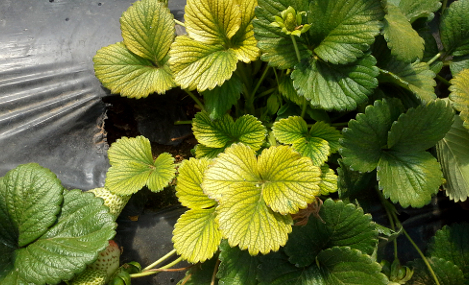Plant Nutrients & Deficiencies
Some healthy plants naturally have marked patches, spots of different colors or patterns in their leaves. So before you investigate your plants health you will need to know what your plant should look like when healthy.
Plant nutrition
Plants, like people, need a balance of nutrients. Too much or too little of a nutrient can lead to unhealthy and poorly producing plants.

Macro & micro nutrients
There are two types of nutrients that make for a healthy plant: macronutrients and micronutrients. This is why pouring NPK fertiliser on your sick plant will often not make it healthier nor will it make your vegies taste better. NPK fertilisers have only 3 of the necessary plant nutrients: nitrogen (N), phosphorus (P) and potassium (K).
Macronutrients include:
- nitrogen (N)
- phosphorus (P)
- potassium (K)
- sulfur
- calcium
- magnesium
Micronutrients include:
- iron
- boron
- manganese
- zinc
- copper
- chlorine
- molybdenum
Symptoms of Plant Nutrient Deficiencies
Nitrogen (N) – represents life, crucial in the formation of proteins
Nitrogen is a part of all living cells and is a necessary part of all proteins, enzymes and metabolic processes involved in the synthesis and transfer of energy. Nitrogen is a part of chlorophyll, the green pigment of the plant that is responsible for photosynthesis. Helps plants with rapid growth, increasing seed and fruit production and improving the quality of leaf and forage crops.
If Deficient
- Slow growth
- Leaves are smaller and yellowish
Phosphorus (P) – the power broker
Is an essential part of the process of photosynthesis. Involved in the formation of all oils, sugars, starches, etc. Effects rapid growth encourages blooming and root growth.
If Deficient
- Poorly developed root system
- Leaf tips look burnt older leaves may turn dark green or redish
Potassium (K) – the great regulator
Potassium is absorbed by plants in larger amounts than any other mineral element except nitrogen and, in some cases, calcium. Helps in the building of protein, photosynthesis, fruit quality and reduction of diseases.
If Deficient
- Small fruits, susceptible to disease
- Older leaves may wilt
- Leaves are pale, yellow, or yellow-white. (chlorosis)
Calcium (CA) – is the servant
An essential part of plant cell wall structure. Provides for normal transport and retention of other elements. Provides strength in the plant.
If Deficient
- Weak plant
- New leaves are often distorted or irregularly shaped.
Magnesium (MG) – puts the ‘green’ in green plants
Important part of chlorophyll in all green plants and essential for photosynthesis. Activates many plant enzymes needed for growth. Determines the quality of a crop.
If Deficient
- Poor quality crop
- Older leaves turn yellow at the edges creating a green arrow shape in the center.
Sulfur (S)
Essential plant food for production of proteins. Promotes activity and development of enzymes and vitamins. Helps in chlorophyll formation. Improves root growth and seed production. Helps with vigorous plant growth and resistance to cold
If Deficient
- Leaves become yellowish green and exhibit a slow stunted growth
- Stems are woody and small in diameter
Boron (B)
Helps in the use of nutrients and regulates other nutrients. Aids production of sugar and carbohydrates. Essential for seed and fruit development.
If Deficient
- Small fruit that are brown in colour
- Terminal buds may die
Copper (CU)
Important for reproductive growth. Aids in root metabolism and helps in the utilization of proteins.
If Deficient
- Probable loss in grain yield
- Probable loss in straw yield
- Leaves are dark green
- Plant is stunted
Chloride (CL)
Aids plant metabolism.
If Deficient
- Root growth is slow
Iron(FE)
Essential for formation of chlorophyll.
If Deficient
- Stunted growth and leaves may drop easily
- Yellowing occurs between the veins of young leaves
Manganese (MN)
Functions with enzyme systems involved in breakdown of carbohydrates, and nitrogen metabolism.
If Deficient
- Reduced plant size and decreased fruit production
- Yellowing occurs between the veins of young leaves
Molybdenum(MO)
Helps in nitrogen metabolism and synthesis of proteins.
If Deficient
- Pale leaves that may be scorched, cupped or rolled
Zinc (ZN)
Essential for the transformation of carbohydrates. Regulates consumption of sugars. Part of the enzyme systems which regulate plant growth.
If Deficient
- Plants fail to develop normally
- Yellowing occurs between the veins of new leaves

